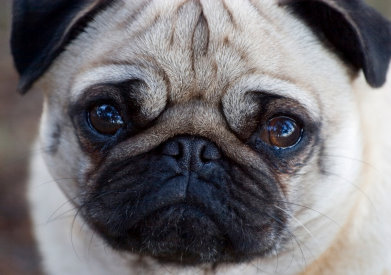|
The Pug FaceIs There Anything Cuter?
The Pug face is one of the trademarks of this special breed of dog. It is the characteristic that catches your attention first and probably the thing that makes this dog almost irresistible. How do you begin to describe such a cute face? Let's begin with the eyes – those large, sensitive and expressive windows into this dog’s lovable personality. A pug’s eyes are dark and very large for the size of his head. The eyes are probably the most prominent feature of the Pug face. They are very soft in expression and can sometimes give the impression that he is sad or worried. Not to worry - Pugs are a very happy breed of dog and make great and playful companions. The eyes are very expressive and can seem to full of mischief if your Pug is in a playful mood. This is usually quite often. Just one note of caution on the eyes, however. Because they are so prominent and this little dog can be quite active, they are prone to injury and require extra care. Any eye injury can be very painful to your Pug so you should seek medical attention right away. Another distinguishing characteristic is the abundance of wrinkles. Again, because of the “furrowed brow”, this can make a Pug look worried. Usually their only worry or concern is their next meal. The wrinkles give this breed a very distinctive look. The wrinkles are large, deep and are above and below the eyes. There’s a large wrinkle that runs under the eyes and above the nose that is referred to as a “nose roll”. The wrinkles also require special care. Bacteria can get caught in the wrinkles so this should be a part of any grooming process. The Pug’s face is large because the head itself large. The head should be round rather than elongated and there should be no indentation of the skull. The Pug face is short and flat. This structure is sometimes categorized as a brachycephalic breed and it refers to the short snout or nose. This can cause some respiratory problems for some Pugs but certainly not in all dogs that have a short, flat face. They can be more prone to over heating on hot days because their air passages tend to be smaller. It is not unusual to have a snoring Pug either. This can be cause for annoyance or it just makes your little friend even more endearing. The ears of a Pug are small and thin and can either fall forward, which is called a button ear, or back, which is called a rose ear. On a button ear the flap covers the ear opening and the tip lies close to the skull. With a rose ear you can see the inside of the ear. The Pugs teeth are usually a little bit undershot. This means the front teeth on the bottom are actually in front of top front teeth. One thing to note is that the Pug has a lot of teeth for such a small mouth. Because of this, extra care needs to be taken with your Pug's teeth. There are markings on the Pug face that are mentioned in the breed standards that are set by the American Kennel Club. The muzzle, sometimes called the mask, should be as black as possible. This is also true for the ears and the diamond on the forehead. If you look closely at a Pug that represents the standard you will see a diamond shape on top of his head. This can also be referred to as a thumb mark. The Pug face can also be characterized by moles that should also be black. For all of these markings, the blacker they are the better they score with judges in competitions. What if your Pug's face does not have all of these markings or they’re not as black and well defined as they should be? It may mean that your Pug will not do well in conformation events or Dog Shows. That doesn’t make your Pug an inferior dog. Perhaps it won’t meet the standards set for the breed. But it does meet the standard of being a very lovable and adorable companion! |